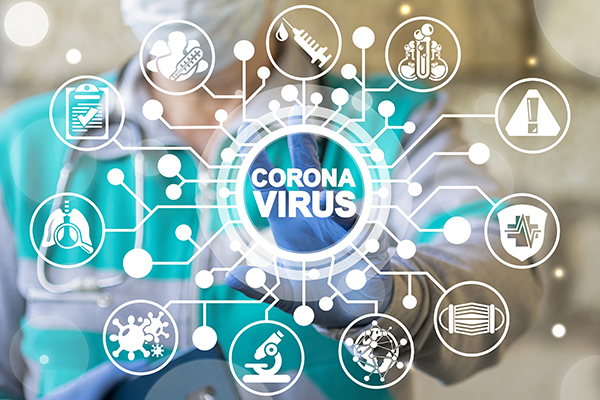
COVID-19—Biotechnology Is Never Enough… But Systems Thinking about Innovation within Its Societal Context Could Be
By: Jennifer Kuzma, Khara D. Grieger, Zachary S. Brown, Patti Mulligan, and Christopher L. Cummings
Imagine the year is 2025… and as a society, we have:
- a COVID-19 vaccine that is safe (e.g. less than 0.0001% for adverse incidents) and effective for all variants of the virus and its relatives,
- a rapid COVID-19 test that has high specificity and sensitivity and gives results within hours, and
- low-cost treatment for COVID-19, ensuring the survival of most everyone who gets infected.
But these will likely not be enough to stop a future pandemic. The currently-unfolding COVID-19 case boldly underscores the reality that science and technology are never enough to solve global health problems alone. Rather, we need a strategic and systematic integration of social sciences, risk sciences, and communication along with science, technology, and innovation to adequately meet the challenges of emerging global risks, such as COVID-19. Simply put, complex global issues require integrated and insightful solutions.
As of early April, we have failed to coordinate simple actions to save thousands of lives. We cannot procure masks, gloves, and ventilators and distribute them to areas of need, largely due to political and market-based factors that require deeper understanding and correction. We cannot get people to trust scientific experts and their pleas to socially distance, largely due to cognitive biases and the psychosocial dimensions of risk management that we do not fully grasp. Due to such systemic failings, the latest projections from the White House’s coronavirus task force anticipate that between 100,000 and 240,000 people will die during this pandemic in the U.S. alone and Director of the National Institute of Allergy and Infectious Diseases, Dr. Anthony Fauci states, “We’re going to have millions of cases”[1]. As we collectively watch the pandemic and response unfold, it has become clear that the most important preventative actions that can be taken today starkly illustrate the importance of the social sciences in making such actions as effective (and as cost-effective) as possible. It is therefore puzzling to receive calls from agencies and foundations for “rapid-response” COVID bioscience research ideas that they can immediately fund. The problems of COVID-19 and priorities of these funders seem misaligned and poorly timed.
In addition to these short-term asymmetries, the COVID case underscores the need to revamp the longer-term U.S. federal R&D portfolio, especially as they apply to emerging global health risks and risk prevention. It is increasingly difficult to reconcile the most pressing challenges we face with the COVID outbreak with U.S. research portfolios. For example, consider the budget of the Department of Health and Human Services (DHHS) that is directed towards academic R&D—out of a budget of $23 Billion, only $0.35 B was devoted to social sciences.[2] DHHS is the biggest funder of academic social science R&D, yet only 1.5% of its budget went to it. Funding for COVID vaccine, test, and treatment development is indeed vital, but it will not suffice for the next pandemic. Vaccines, treatments, and tests must be deployed in complex socioeconomic and political systems. People must have access to them and confidence in their safety and effectiveness. Health officials and providers need to be trusted for good information.
No amount of biotechnology advancement can overcome the psychosocial, socio-economic, and political barriers causing inaction and distribution inefficiencies. We also need research that takes into account these challenges.
For example:
- Appreciating how health risks translate to individual risk perceptions and to collective social action will continue to be a critical scientific endeavor, and in other contexts such as energy conservation the social and behavioral sciences have led to strategies that are sometimes significantly more cost-effective than more new technologies.[3] Recent empirical analysis has shown for other transmissible diseases that individual vaccination decisions may be more based on the saliency of available public information than on the actual underlying disease risks.[4] Trust in communicators is another important factor for public perceptions of risk—research is needed to identify factors that enable risk managers to gain public faith in the case of COVID.
- Understanding the interaction between social distancing behaviors and vaccination under different modes of risk communication could be critical information for effective policy making. It would be wise to invest now in robust science communication, prediction of the likely public responses to any eventual COVID-19 vaccine, and how these interact with social distancing behaviors. Modeling research has shown that including feedback effects between individual social distancing behaviors and transmission dynamics can dramatically alter predictions as compared to the standard, ‘off the shelf’ models usually used to predict disease spread and prevalence.[5]
- Investigating how the design of political systems, public organizations, and public-private partnerships facilitate or inhibit the deployment of vaccines, treatments, or medical equipment, as well as risk communication programs is the type of work that is under-appreciated and seldom funded. Governance systems and public administration research are needed to connect basic social science research with the practice of decision-making and program delivery.[6] Operations research should be connected to organizational behavior under different political regimes, so we never again bungle the procurement and distribution of medical equipment.
The Genetic Engineering and Society (GES) Center has taken the position since its inception that the social sciences and humanities are as important for solving global challenges as the natural sciences and engineering. Technology development and adoption require not only successful scientific and technological innovation, but also—and perhaps more importantly—coordinated people, political systems, and socio-economic structures for effective deployment. In fact, it may even be argued that addressing the root cause of problems often requires little to no technological intervention. “Flattening the curve” is a prime example, for which psychosocial dimensions underlying social distancing must be understood for effective risk communication. As our world continues to become more global and interconnected, so too must our coordinated efforts in dealing with catastrophically lethal risks like COVID-19.

We can no longer neglect the sociological, political, and economic dimensions of pandemics and other global health problems. By giving equal deference (and funding) to the natural and social sciences, we can devise the infrastructure, programs, and processes to make the best use of science and technology. Otherwise, we put ourselves at continued risk with an over-investment in biosciences and an underinvestment in the socio-political contexts surrounding pandemics and biotechnological remedies to counteract them.
Now, imagine the year 2025 again… as a society, we have a comprehensive understanding from social and behavioral sciences, risk communication, and policy studies about their synergies with the deployment of emerging biotechnologies. Robust, systemic solutions for COVID are realized, we are better prepared for new variants of COVID that are likely to arise[7], and millions of lives can be saved.
[1] McFall-Johnsen, M. (2020) “US will have ‘millions of cases’ and over 100,000 coronavirus-related deaths, Fauci says” Business Insider, 29 March 2020. https://www.businessinsider.com/fauci-us-will-see-millions-of-cases-100000-coronavirus-deaths-2020-3
[2] National Science Board (2020). The State of US Science and Engineering 2020. https://ncses.nsf.gov/indicators
[3] Allcott, H. (2011). Social norms and energy conservation. Journal of Public Economics, 95(9-10), 1082-1095. https://www.sciencedirect.com/science/article/abs/pii/S0047272711000478
[4] Oster, E. (2018). Does disease cause vaccination? Disease outbreaks and vaccination response. Journal of Health Economics, 57, 90-101. https://linkinghub.elsevier.com/retrieve/pii/S016762961730440X
[5] Fenichel, E. et al. (2011). Adaptive human behavior in epidemiological models. Proceedings of the National Academy of Sciences, 108(15), 6306-6311. https://www.pnas.org/content/108/15/6306
[6] Kuzma, J. (2015). Translational governance research for synthetic biology. Journal of Responsible Innovation, 2(1), 109-112. http://www.tandfonline.com/doi/abs/10.1080/23299460.2014.1002055
[7] Korman, C. (2020) From Bats to Human Lungs, the Evolution of a Coronavirus. The New Yorker. 27 March 2020. https://www.newyorker.com/science/elements/from-bats-to-human-lungs-the-evolution-of-a-coronavirus
